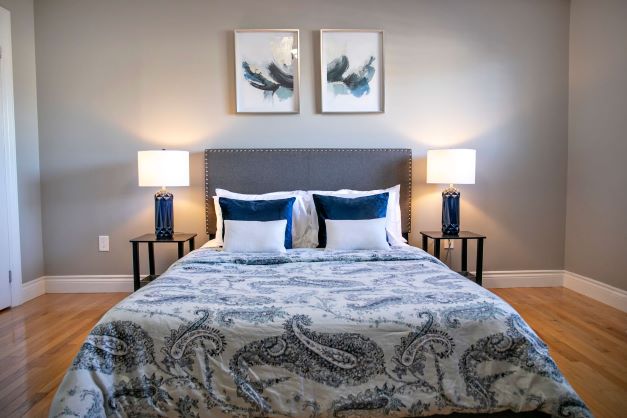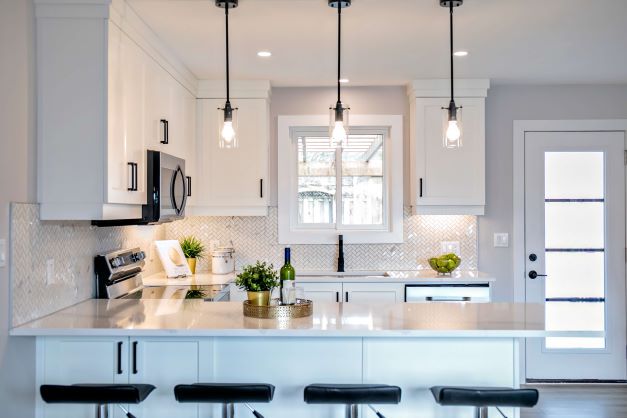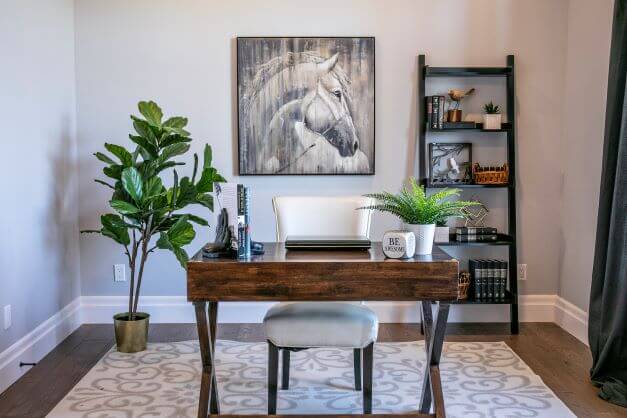The following information is provided by award-winning home staging expert Shauna Lynn Simon. It’s backed up by thousands of clients, up-to-date and independent research, and 14 years of real-world experience in the home staging industry.
There are many paths to becoming a professional home stager and, yes, a career in home staging can provide you with a good stable income.
With the right tools in your pocket, you can start (and grow) your business quickly and efficiently. I’ve personally helped thousands of home stagers from all kinds of backgrounds and economic circumstances to become successful home stagers in their local area.
Here’s what you need to know about how much home stagers make, and how you can kickstart (or rejuvenate) a career as one!
What does a home stager do?
Home staging is the art of furnishing and decorating a home to make it aesthetically appealing to anyone walking through the front door. A professional stager typically works with real estate agents or home sellers to prepare and stage owner-occupied and vacant homes prior to listing their property for sale in their local real estate market.
Professional staging is not the same as interior design. Interior designers work with clients and create an environment based on their personal likes, dislikes, personal functional needs and preferred home look.
A home stager, in contrast, is trained to turn open houses into future homes that potential buyers find universally attractive. Selling a home is about marketing to today’s home buyers.
The day-to-day life of a home stager involves:
- Doing consultations with new clients.
- Planning room layouts and furnishings.
- Physically managing the movement and placement of ALL decor and furniture into vacant show houses.
- Advising clients on how to arrange their existing furniture and decor
- Helping clients clear clutter, clean surfaces and repair cosmetic defects
- And much, much more!

Home stagers often work to make small spaces appear bigger and more attractive to prospective buyers.
Why do people hire home stagers?
Home stagers position homes against their competition so that they stand out to and attract buyers. With more buyers interested in a home, the property will sell at a higher price — often 5-10% above the asking price. In most cases, it also helps the home sell after spending very little time on the market (1-2 weeks). If you think about a $500,000 home, a mere 5% increase in sale price net’s the seller an extra $25k! Considering the cost of staging, their return on investment is five times more than the cost of staging.
Three types of home stagers
While estate agents have governing bodies like the National Association of Realtors ® as well as state/provincial licensing boards, there’s no formal roadmap to becoming a home stager. In a self-regulated industry, the Real Estate Staging Association (RESA) provides standards and professional guidelines for members, however, membership is not mandatory to be a home stager.
As a home stager, your revenue is based on referrals from happy customers, partnerships with real estate agents, and the success of your marketing efforts within your area.
Here are the different ways you can run a home staging business.
Consultations-only
You help homeowners develop a DIY plan of action in your initial consultation. This business model doesn’t require much capital to start, but you will spend less time doing actual staging, and more time advising, planning, and building resources.
In-house
In-house stagers work for real estate agencies or home staging businesses. To find a full-time job in home staging, you need a portfolio of work, training, and experience. You may also start out as a staging assistant while learning the ropes.
Full-service business
A full-service home stager manages home staging projects from start to finish. They hold consultations, plan staging designs, arrange for furniture and decor to be moved or replaced, and physically set the stage of the house for prospective buyers. This type of business requires an inventory of furnishings that you rent to your clients or an agreement with a third-party furniture rental service.
Real estate agents are known to exclusively engage the services of a full-service home staging business.

A professional home stager makes spaces aesthetically pleasing and creates a blank slate for the new owners.
How much money can you make staging homes?
Data supplied by ZipRecruiter indicates that most people working as a home stager will earn between $26,000 and $42,000 per year. The top 15% of home stagers earn between $48,000 and $81,000. (Note: The average salary of a home stager works out to be around $48,000, thanks to these outliers.)
If you are running your own home staging business, you will likely bill a rate of anywhere from $100-$200 per billable hour. Alternatively, if you opt to own inventory, you would also make a rental fee on items you use in a staged home. If you choose to work for a home staging company, your pay rate will depend greatly on your role and responsibilities within their company, however, you can expect to make an hourly rate between $15-$50.
But stats without context don’t really give you the full picture.
Let’s dive into what your monthly income might look like as a solo business owner.
Consultation fees on average cost +/- $300. This covers a couple of hours in which you assess the current state of the house, the number of rooms you need to stage, what the future home will look like, and the amount of work required. This consultation usually includes an upsell tailored to the client with one of the following solutions:
- Complete staging in each room with your inventory.
- Affordable staging with their EXISTING household items.
- A hybrid solution, such as staging key rooms only like the living room and master bedroom only, or providing a mix of your inventory with their existing items.
Each room staged with your inventory can be charged at an industry cost of roughly $500 per month. (It’s possible to charge much higher prices and furniture rental fees to clients if you work with luxury homes.)
Based on these numbers, the following monthly scenario could be what a 1-person business brings in every month:
- 6 x Consultations: $2,400.
- 2 x medium-sized staged homes for one month: $4,000.
- 2 x service-only stagings to stage the house with existing items: $1,000.
And that works out to a monthly gross revenue of $7,400. Next, you need to factor in your expenses to know how much you actually take home.
Understanding your local market
Different locations will allow you to charge varying fees. For example, stagers in New York and Los Angeles will charge a premium for their services due to increased expenses, cost of living, and luxury expectations. On the other end of the spectrum, stagers in a small town an hour outside of Ohio may find that their market won’t bare the same prices and may need to price their service fees far lower.
Factoring in your expenses
While most people will be happy to throw big salary numbers at you, they neglect to mention the costs of securing that revenue. I’ve noticed many people feel overwhelmed by the idea of expenses and operating costs, but it’s all part of running a business. And once you understand your expenses, setting goals and following budgets is as easy as pie.
When creating your business plan, think about the additional cost to do the following:
- The purchase or rental costs of your inventory.
- Training and certification in home staging and business skills.
- Your finance and administration costs (e.g., a bookkeeper).
- Movers, trucks, and storage fees.
- Mobile phone and internet costs.
- Marketing costs (such as a website developer, social media manager, and even Google ads).
- General office supplies.
There are some clever ways to manage and curb your expenses while you’re growing your home staging business. Here are a few great options:
Option 1: Go all-in at the start
This is the method I personally chose. Because I purchased the bulk of Beyond the Stage’s furniture and decor upfront, I expected to run at a loss for a whole five years (home staging was an extremely new concept in my market at the time). In reality, that panned out slightly better, and it took just a little more than three years for us to become a profitable business. And boy was it worth it! I have enough inventory to stage several houses at any one time, and I was quickly becoming the go-to in my area.
This option is entirely possible, but it will take some upfront investment — so you need to go in with a clear plan for not only operating the business but paying your personal expenses (i.e. do you have savings, spousal support, or a second job that could assist in covering costs while you build the business?).
Option 2: Start slow with consults and furniture rentals
Instead of purchasing your large inventory off the bat, keep costs low and rent them from furniture rental companies. Running a consults-only business avoids the expense of moving furniture in and out of houses entirely. Recently, virtual consults have helped stagers reach an even larger market while keeping their running costs at an all-time low. If you wish to provide inventory to clients, invest in the small goods only and leave the big stuff to a furniture rental company to provide. Alternatively, you can assist your clients with shopping for the staging items they need, and since they purchase the items themselves, they get to keep them in the next house!
Option 3: Become a home staging assistant
This has a little less of the glory, but provides a close-up look at the ins and outs of a home staging business, without the upfront investment. You will help a home stager assemble furniture, clean surfaces, make and steam beds, arrange movers, and more. If you feel nervous about entering the industry, it’s a great foot in the door. I’ve trained many assistants over the years and have found it’s crucial to have some training before you start.
Home staging tips for people looking to enter the industry
- Passion for home decor is a must!
On those days where you need to put yourself out there and give that little push to get yourself on the right trajectory… it’s passion that will keep you going. - Build systems from day one.
It all comes down to the systems you create. If you have a strategy for virtual staging consults, traditional homes, and empty homes, you can free yourself from repetitive admin work and focus on getting new clients. - Get clear on your target clients from the start.
Home staging is still a people game. Understanding where your clients will come from, and how best to interact with them, will be your secret to success. - Invest in professional photography.
This is your biggest sales tool and poor quality photos (no matter how great your smartphone camera is) could turn off clients before they’ve even contacted you.
Resources to help you get started
Styled, Listed, and Sold (SLS) Academy has all the resources you need to start a career in home staging. Unlike other training programs and academies, we also focus on business skills — our comprehensive training has helped many of our students grow a profitable business from scratch.
If you’re ready to take your passion for décor and turn it into a profitable staging business, sign up for our free home staging starter training. You’ll learn the insider secrets to building a successful staging career, from client acquisition to pricing strategies. Let’s take that passion and turn it into a career you’ll love!


Facebook Comments